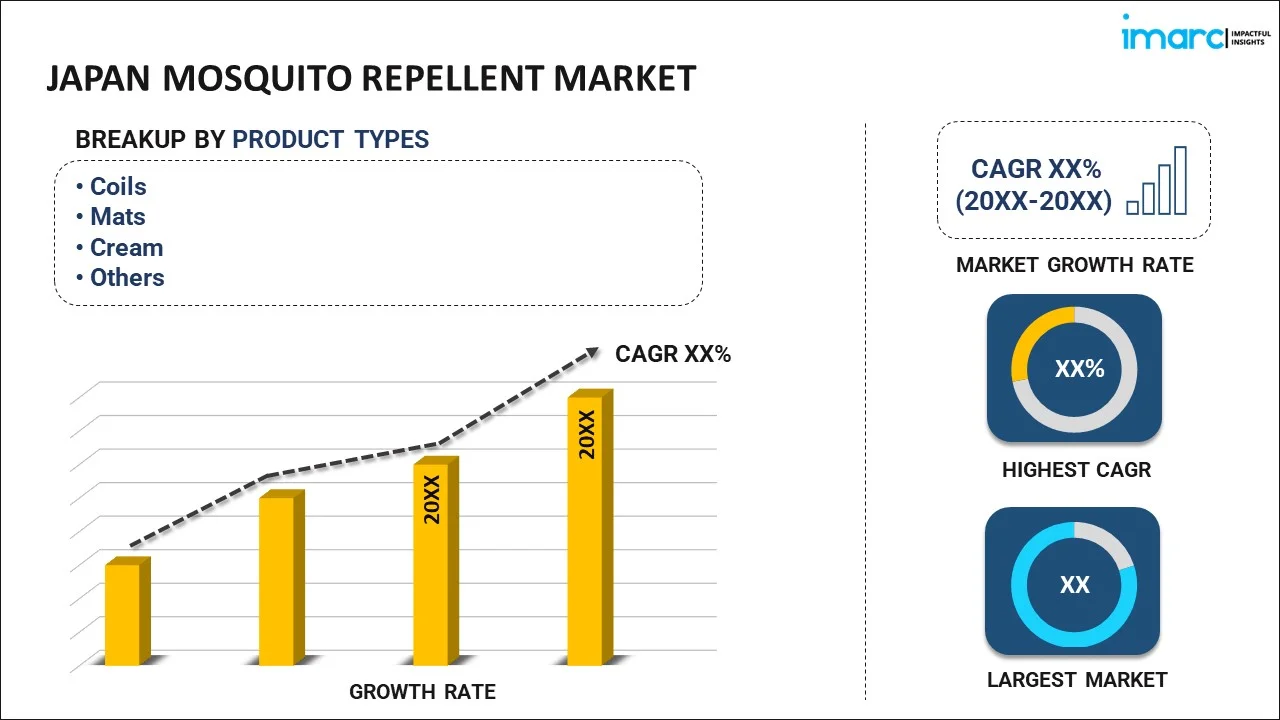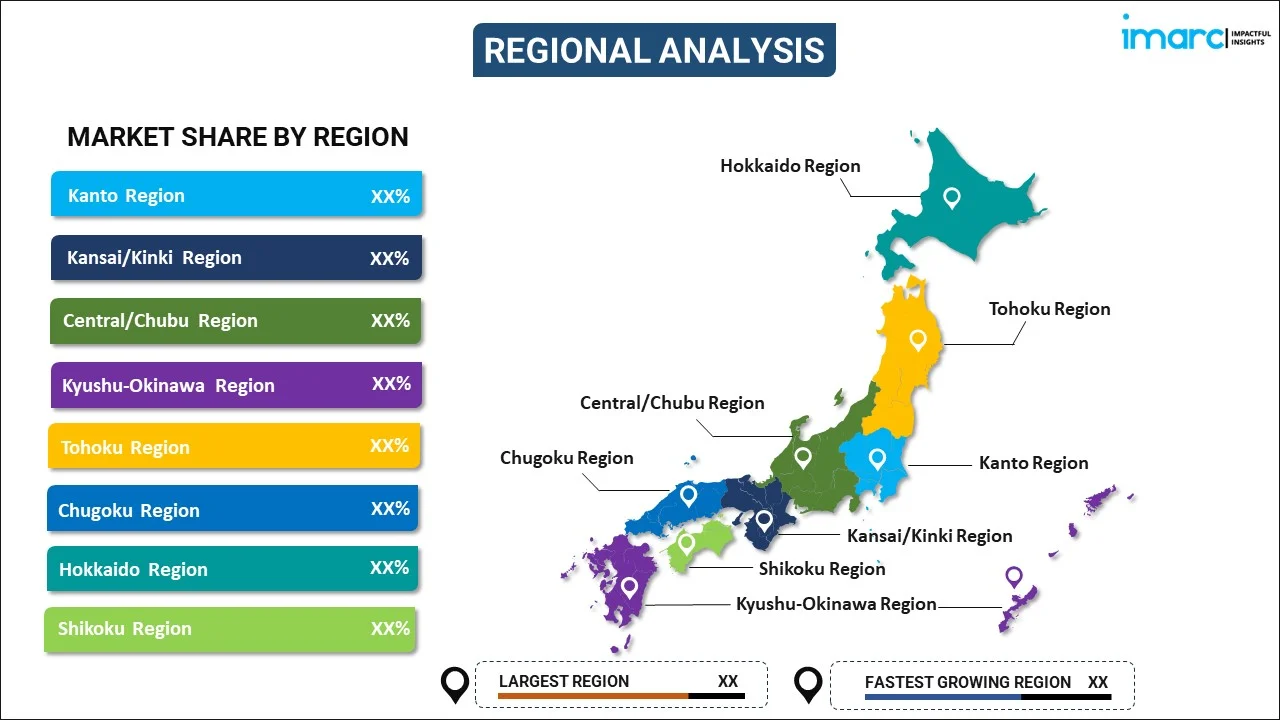
Japan Mosquito Repellent Market Report by Product Type (Coils, Mats, Cream, Oils, Vaporizer, and Others), Ingredients Type (Natural Ingredients, Synthetic Ingredients), Distribution Channel (Convenience Stores, Departmental Stores, Supermarkets and Hypermarkets, Online, and Others), and Region 2025-2033
Market Overview:
Japan mosquito repellent market size reached USD 313.0 Million in 2024. Looking forward, IMARC Group expects the market to reach USD 470.0 Million by 2033, exhibiting a growth rate (CAGR) of 4.6% during 2025-2033. The growing adoption of natural mosquito repellents with ingredients such as thyme oil is primarily driving the market growth.
|
Report Attribute
|
Key Statistics
|
|---|---|
|
Base Year
|
2024 |
|
Forecast Years
|
2025-2033
|
|
Historical Years
|
2019-2024
|
| Market Size in 2024 | USD 313.0 Million |
| Market Forecast in 2033 | USD 470.0 Million |
| Market Growth Rate (2025-2033) | 4.6% |
Mosquito repellent is a substance or product crafted with the purpose of discouraging mosquitoes from approaching or biting humans. Typically, it contains elements that deter mosquitoes by disrupting their sensory receptors, thereby making it challenging for them to detect the presence of humans. Common active components found in mosquito repellents encompass DEET, picaridin, as well as natural extracts, such as citronella oil or lemon eucalyptus oil. These repellents are available in various formats, including sprays, lotions, creams, and wearable devices. Through the application or use of mosquito repellents, individuals can reduce their exposure to mosquito bites and decrease the risk of contracting mosquito-borne diseases such as malaria, dengue fever, or Zika virus.
Japan Mosquito Repellent Market Trends:
In Japan, the heightened prevalence of mosquito-borne diseases on a wide scale has created a growing demand for effective mosquito repellents, which is primarily driving the market growth. Governments and healthcare organizations are actively advocating the use of mosquito repellents as a preventive measure against the spread of these diseases. Furthermore, there is an increasing level of awareness among consumers regarding the critical importance of personal protection against mosquitoes, thereby positively influencing the regional market. Additionally, the expansion of the travel and tourism industry has played a role in driving market growth. As more individuals explore tropical destinations or regions known for high mosquito activity, the demand for dependable mosquito repellents has seen a notable increase. Besides this, advancements in product formulations and technology have resulted in the creation of repellents that are more efficient and longer-lasting, further stimulating market growth. Moreover, manufacturers are introducing innovative solutions to cater to the preferences of environmentally conscious consumers. These innovations include wearable repellent devices and formulations based on natural ingredients. Apart from this, the rising disposable income in emerging economies has led to increased purchasing power among consumers, enabling them to afford mosquito repellents. This economic factor is expected to contribute to the growth of the market in Japan over the forecasted period.
Japan Mosquito Repellent Market Segmentation:
IMARC Group provides an analysis of the key trends in each segment of the market, along with forecasts at the country level for 2025-2033. Our report has categorized the market based on product type, ingredients type, and distribution channel.
Product Type Insights:

- Coils
- Mats
- Cream
- Oils
- Vaporizer
- Others
The report has provided a detailed breakup and analysis of the market based on the product type. This includes coils, mats, cream, oils, vaporizer, and others.
Ingredients Type Insights:
- Natural Ingredients
- Oil of Lemon Eucalyptus
- Citronella
- Others
- Synthetic Ingredients
- DEET
- Permethrin
- Picaridin
- Others
A detailed breakup and analysis of the market based on the ingredients type have also been provided in the report. This includes natural ingredients (oil of lemon eucalyptus, citronella, and others) and synthetic ingredients (DEET, permethrin, picaridin, and others).
Distribution Channel Insights:
- Convenience Stores
- Departmental Stores
- Supermarkets and Hypermarkets
- Online
- Others
The report has provided a detailed breakup and analysis of the market based on the distribution channel. This includes convenience stores, departmental stores, supermarkets and hypermarkets, online, and others.
Regional Insights:

- Kanto Region
- Kansai/Kinki Region
- Central/ Chubu Region
- Kyushu-Okinawa Region
- Tohoku Region
- Chugoku Region
- Hokkaido Region
- Shikoku Region
The report has also provided a comprehensive analysis of all the major regional markets, which include Kanto Region, Kansai/Kinki Region, Central/ Chubu Region, Kyushu-Okinawa Region, Tohoku Region, Chugoku Region, Hokkaido Region, and Shikoku Region.
Competitive Landscape:
The market research report has also provided a comprehensive analysis of the competitive landscape. Competitive analysis such as market structure, key player positioning, top winning strategies, competitive dashboard, and company evaluation quadrant has been covered in the report. Also, detailed profiles of all major companies have been provided. Some of the key players include:
- Fumakilla Co. Ltd.
- Dainihon Jochugiku Co. Ltd.
- Earth Corporation
- SC Johnson Company Ltd.
(Please note that this is only a partial list of the key players, and the complete list is provided in the report.)
Japan Mosquito Repellent Market Report Coverage:
| Report Features | Details |
|---|---|
| Base Year of the Analysis | 2024 |
| Historical Period | 2019-2024 |
| Forecast Period | 2025-2033 |
| Units | Million USD |
| Scope of the Report | Exploration of Historical Trends and Market Outlook, Industry Catalysts and Challenges, Segment-Wise Historical and Future Market Assessment:
|
| Product Types Covered | Coils, Mats, Cream, Oils, Vaporizer, Others |
| Ingredient Types Covered |
|
| Distribution Channels Covered | Convenience Stores, Departmental Stores, Supermarkets and Hypermarkets, Online, Others |
| Regions Covered | Kanto Region, Kansai/Kinki Region, Central/ Chubu Region, Kyushu-Okinawa Region, Tohoku Region, Chugoku Region, Hokkaido Region, Shikoku Region |
| Companies Covered | Fumakilla Co. Ltd., Dainihon Jochugiku Co. Ltd., Earth Corporation, SC Johnson Company Ltd., etc. |
| Customization Scope | 10% Free Customization |
| Post-Sale Analyst Support | 10-12 Weeks |
| Delivery Format | PDF and Excel through Email (We can also provide the editable version of the report in PPT/Word format on special request) |
Key Questions Answered in This Report:
- How has the Japan mosquito repellent market performed so far and how will it perform in the coming years?
- What has been the impact of COVID-19 on the Japan mosquito repellent market?
- What is the breakup of the Japan mosquito repellent market on the basis of product type?
- What is the breakup of the Japan mosquito repellent market on the basis of ingredients type?
- What is the breakup of the Japan mosquito repellent market on the basis of distribution channel?
- What are the various stages in the value chain of the Japan mosquito repellent market?
- What are the key driving factors and challenges in the Japan mosquito repellent?
- What is the structure of the Japan mosquito repellent market and who are the key players?
- What is the degree of competition in the Japan mosquito repellent market?
Key Benefits for Stakeholders:
- IMARC’s industry report offers a comprehensive quantitative analysis of various market segments, historical and current market trends, market forecasts, and dynamics of the Japan mosquito repellent market from 2019-2033.
- The research report provides the latest information on the market drivers, challenges, and opportunities in the Japan mosquito repellent market.
- Porter's five forces analysis assist stakeholders in assessing the impact of new entrants, competitive rivalry, supplier power, buyer power, and the threat of substitution. It helps stakeholders to analyze the level of competition within the Japan mosquito repellent industry and its attractiveness.
- Competitive landscape allows stakeholders to understand their competitive environment and provides an insight into the current positions of key players in the market.
Need more help?
- Speak to our experienced analysts for insights on the current market scenarios.
- Include additional segments and countries to customize the report as per your requirement.
- Gain an unparalleled competitive advantage in your domain by understanding how to utilize the report and positively impacting your operations and revenue.
- For further assistance, please connect with our analysts.
 Inquire Before Buying
Inquire Before Buying
 Speak to an Analyst
Speak to an Analyst
 Request Brochure
Request Brochure
 Request Customization
Request Customization




.webp)




.webp)












